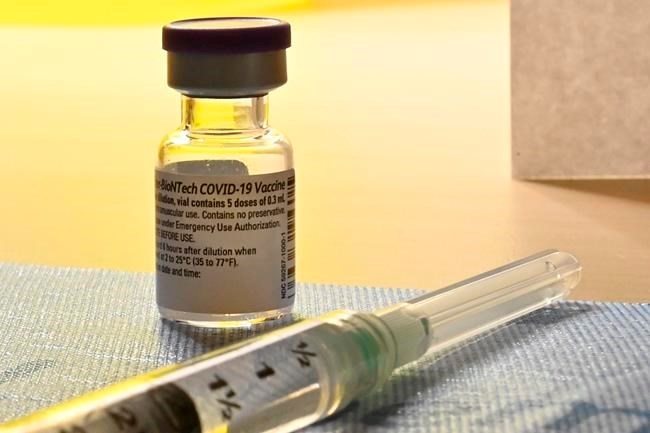TORONTO — Special syringes that help generate extra doses of COVID-19 vaccines may be in demand right now, but one expert says the country shouldn't treat it as the only solution to getting Canadians inoculated as quickly as possible.
So-called low dead space syringes, which limit vaccine getting trapped in the needle, have become popular in recent weeks as many countries try to capture six doses from each Pfizer-BioNTech COVID-19 vaccine vial instead of the standard five.
But Kelly Grindrod, an associate professor at the University of Waterloo's pharmacy school, said one-millilitre syringes and alternate vaccines are just as important to the country's inoculation efforts.
"What we're seeing now is that (vaccination) is really messy business and having more options in the long run actually will be a lot better for us than hanging our hat on one," she said.
Talk of how to generate more COVID-19 vaccines from limited shipments has been a hot topic since December, when Canadians started rolling up their sleeves and technologists realized vials included enough vaccine that an additional dose per vial was within sight.
Low dead space needles seemed like an easy solution for stretching the supply.
For example, TSK Laboratory, a Japanese company that manufactures needles, said that if the European Union used their low dead space needles on the 100 million citizens they'd purchased Pfizer-BioNTech vaccine for, an additional four to eight million people could be vaccinated.
However, most countries don't have stockpiles of these needles.
The syringes, Grindrod said, are most often used for expensive medicines where governments and patients want to keep costs low.
They are also popular with users of illicit drugs, she said.
"You might also see these being used in a hospital pharmacy department when they're preparing drugs," she said.
Getting more of these needles isn't as simple as filling out an order sheet. Coming up with more of these needles takes time and money, and is tougher now there is high global demand.
The Canadian Press reached out to six needle manufacturers in Canada and abroad, but none would share whether they're supplying the country or able to quickly pivot to make this kind of needle.
"Low dead space syringes are niche products and there has been minimal market demand based on health care provider needs," said medical device manufacturer Becton, Dickinson and Company in an email to The Canadian Press.
The company has so far provided 42 million of the 75 million vaccination devices it agreed to ship to Canada. The remainder, due to arrive in March, are all standard needles.
Grindrod said there's another kind of needle that would help keep vaccine waste lower: one-millilitre syringes.
They make it easier to get an extra dose than three-millilitre syringes and they're much more readily available, she said.
"We've heard of hospitals and vaccine programs trying to contact vet clinics, for example, to see if they have one-millilitre syringes around because they might be using more small volumes," she said.
"It's the one-millilitre in particular that they've been concerned that they're running out of."
Last year, Public Services and Procurement Canada offered contracts for 145 million syringes, 95 million of which are of the three- or five-millilitre varieties.
There are 50 million one-millilitre syringes on order, including 37.5 million low-dead-volume versions.
But Grindrod pointed out that even with the best supplies, there's no guarantee a sixth dose can be squeezed from the vaccine vial. She said even with the right kind of needles, hospital pharmacy programs are finding the extra dose is available eight times out of 10.
That rate is likely to fall when vaccination becomes more widespread and nurses or doctors unused to inoculation are on duty, she said.
"These folks are used to multi-dose vials because flu shots often come as multi-dose vials, but maybe they're not drawing many like that other than flu shots for a few months a year," she said.
"It's not like they're in the pharmacy doing hundreds of these every day like technicians might be."
That's why Grindrod believes Canada has to combine low dead space needles, one-millilitre syringes and other vaccines we have yet to approve or receive, even if the efficacy rate is a bit lower.
So far, health-care workers and long-term care residents have been vaccinated with the Pfizer-BioNTech or the Moderna vaccine, but both companies are slowing down shipments as they deal with high demand and need to retool their manufacturing processes.
AstraZeneca and Johnson and Johnson have made vaccines too, but they've yet to land in Canada and their efficacy rates trail Pfizer-BioNTech and Moderna.
If Canada deems those vaccines or others safe and is able to receive shipments quickly, Grindrod said they could be allocated to younger and healthier Canadians.
The higher-efficacy vaccines could be left for those who are vulnerable, such as the elderly or those with severe health complications, she said.
"The most important thing right now is that you've got one of them, not that you've got the better one."
This report by The Canadian Press was first published Jan. 29, 2021.
Tara Deschamps, The Canadian Press



